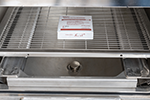What are chemical indicators used for?
 Chemical indicators (CIs), as defined by the Association for the Advancement of Medical Instrumentation (AAMI) and International Organization for Standardization (ISO), are devices used to monitor the presence or attainment of one or more of the parameters required for a satisfactory sterilization process or used in a specific test of sterilization equipment. For example, when placed inside packs, chemical indicators are used to confirm that sterilant achieved good penetration in the items being sterilized. Chemical indicators are used as internal and external indicators and as part of routine performance testing and load release. It is important to note that chemical indicators alone do not confirm that an item is sterile.
Chemical indicators (CIs), as defined by the Association for the Advancement of Medical Instrumentation (AAMI) and International Organization for Standardization (ISO), are devices used to monitor the presence or attainment of one or more of the parameters required for a satisfactory sterilization process or used in a specific test of sterilization equipment. For example, when placed inside packs, chemical indicators are used to confirm that sterilant achieved good penetration in the items being sterilized. Chemical indicators are used as internal and external indicators and as part of routine performance testing and load release. It is important to note that chemical indicators alone do not confirm that an item is sterile.
Chemical indicators must be used as part of comprehensive quality control program, that also includes the use of biological indicators and physical monitors, to assure that the conditions for sterilization were met.
When chemical indicators are used as part of a comprehensive quality control program, they can capture failures, such as malfunctioning equipment and technician errors, that could result in a non-sterile device. The use of chemical indicators in sterilization provides confidence in the effective reprocessing of medical devices.
Explore our chemical indicators
How do chemical indicators work?

Chemical indicators are used to monitor whether the parameters to achieve sterilization have been met for a specific sterilization process. Chemical indicators use one or more chemicals that undergo either a physical or chemical change, that is visible to the human eye, after exposure to predetermined critical parameters such as time, temperature and sterilant.

An example of a chemical indicator design that changes physically is a steam indicator strip where the chemical indicator uses a chemical pellet that changes from a solid phase to a liquid phase when it is exposed to steam. Once in a liquid state, the material wicks along a paper strip and is visible through the window in the chemical indicator.
The second type of chemical indicator utilizes one or more chemical reactions to bring about a chemical change. The chemical present in the indicator ink reacts to one or more of the critical parameters of the sterilization process and undergoes a chemical reaction to alter and change the color of the indicator ink to its endpoint color.
This physical or chemical change is observed and interpreted as a pass or fail result and can help Sterile Processing Staff and Surgical Technologists decide whether to release a set of instruments for use.
Learn more about chemical indicators for sterilization and earn free CEs with STERIS University
How are chemical indicators used for sterilization?
Chemical indicators should be used in all types of sterilization processes including: steam, hydrogen peroxide, and ethylene oxide. Sterile Processing Department (SPD) staff should always follow the manufacturer's instructions for use and healthcare compliance organizations' guidelines and requirements when using chemical indicators for sterility assurance monitoring.
Chemical indicators are required when using a steam sterilization process to verify that the critical parameters of the cycle were met. The way chemical indicators are used with an autoclave process depends on the indicator Type and sterilization cycle. Chemical indicators should be used in conjunction with physical monitors and any other appropriate measure of sterility assurance.
Where to Buy Chemical Indicators?
Healthcare facilities should purchase chemical indicators from a reliable, accessible source for easy reordering. Chemical Indicators can be purchased from companies that offer sterilization and infection prevention products. Factors that may be considered when deciding which chemical indicators to purchase include sterilization modality being monitored, performance, brand name, cost, range and variety of products, validated applications and ease of use. Refer to ISO 14161 for more information on supplier selection.
STERIS offers a complete portfolio of sterility assurance products including Chemical Indicators.
View all STERIS chemical indicators
1 ANSI/AAMI ST79 Comprehensive guide to steam sterilization and sterility assurance in health care facilities (2017) section 13.5.2.2.2, Internal chemical indicators
 United States
United States
 Canada (EN)
Canada (EN) Canada (FR)
Canada (FR) Deutschland
Deutschland Italia
Italia United Kingdom
United Kingdom Australia
Australia New Zealand
New Zealand Singapore
Singapore Brasil
Brasil México
México
 Chemical indicators (CIs), as defined by the Association for the Advancement of Medical Instrumentation (AAMI) and International Organization for Standardization (ISO), are devices used to monitor the presence or attainment of one or more of the parameters required for a satisfactory sterilization process or used in a specific test of sterilization equipment. For example, when placed inside packs, chemical indicators are used to confirm that sterilant achieved good penetration in the items being sterilized. Chemical indicators are used as internal and external indicators and as part of routine performance testing and
Chemical indicators (CIs), as defined by the Association for the Advancement of Medical Instrumentation (AAMI) and International Organization for Standardization (ISO), are devices used to monitor the presence or attainment of one or more of the parameters required for a satisfactory sterilization process or used in a specific test of sterilization equipment. For example, when placed inside packs, chemical indicators are used to confirm that sterilant achieved good penetration in the items being sterilized. Chemical indicators are used as internal and external indicators and as part of routine performance testing and 







